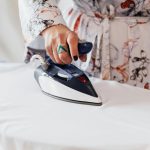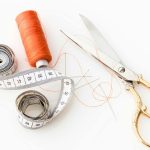You’ll want to choose a medium-weight fabric, around 5-7 oz per square yard, for your batik projects. This weight gives you durability and excellent dye absorption, ensuring vibrant, long-lasting patterns. Lightweight fabrics, 3-4 oz, suit airy garments like scarves, while heavier ones work well for bags or upholstery. Fabric weight also affects how dyes behave and how crisp your designs appear. If you keep exploring, you’ll discover more about matching fabric types and weights to your specific batik needs.
Table of Contents
Key Takeaways
- Batik fabric commonly uses medium-weight fabrics, around 5-7 oz/yd², balancing durability and dye absorption quality.
- Lightweight fabrics (3-4 oz/yd²) are preferred for delicate items like scarves, offering breathability and fine dye detail.
- Heavyweight fabrics (8+ oz/yd²) suit bags and upholstery due to their sturdiness and dye retention.
- Fabric weight affects dye behavior: heavier fabrics absorb dye slowly for crisp patterns, lighter fabrics absorb quickly but may blotch.
- Natural fibers like cotton (4-6 oz) are favored for vibrant batik dyeing and comfortable wear.
Understanding Fabric Weight Measurements
When you look at batik fabric, understanding its weight measurements helps you choose the right material for your project.
Fabric weight is usually measured in grams per square meter (GSM) or ounces per square yard (oz/yd²). These numbers tell you how heavy or dense the fabric is. A higher number means a thicker, heavier fabric, while a lower number indicates a lighter, more delicate material.
By knowing these measurements, you can predict how the fabric will drape, feel, and perform. This knowledge prevents surprises when you start working on your batik piece. Instead of guessing, you make informed choices that suit your design’s needs, whether you want something sturdy or soft.
Understanding fabric weight is your first step toward selecting the perfect batik fabric.
Common Fabric Weights Used in Batik
Knowing how fabric weight influences batik helps you pick the right type for your project.
Understanding fabric weight is key to selecting the perfect batik for your creative project.
Batik fabrics typically come in a range of weights, each suited for different uses and effects. You’ll find that medium-weight fabrics are the most common, offering durability and ease of dye absorption. Lighter fabrics provide a delicate feel but require careful handling. Heavier weights give a sturdier texture but may limit intricate designs.
Common fabric weights used in batik include:
- Lightweight (around 3-4 oz/yd²) for scarves and blouses
- Medium-weight (5-7 oz/yd²) for shirts and dresses
- Heavyweight (8+ oz/yd²) for bags and upholstery
- Cotton broadcloth (medium weight, 4-6 oz) for vibrant patterns
- Rayon blends (varied weights) for drapey, soft finishes
Choose based on your project’s needs and desired fabric behavior.
Characteristics of Lightweight Fabrics for Batik
When choosing lightweight fabrics for batik, you’ll notice they usually have a thin thickness range that keeps them breathable and comfortable.
These fabrics often include materials like cotton, silk, and rayon, which work well for detailed designs and everyday wear.
Understanding these characteristics helps you pick the right fabric for your batik projects.
Fabric Thickness Range
Lightweight batik fabrics typically measure between 0.1 to 0.3 millimeters in thickness, offering a delicate feel that drapes effortlessly.
This thinness allows the fabric to move freely, making it ideal for garments that require fluidity and softness. When you choose batik within this thickness range, you get a fabric that’s easy to layer and sew with minimal bulk.
Keep in mind these key points about fabric thickness:
- Thin enough for detailed dye work without cracking
- Lightweight for comfortable wear in warmer climates
- Flexible for intricate pleats and folds
- Suitable for both casual and formal batik styles
- Easy to handle during waxing and dyeing processes
Understanding this thickness range helps you select the perfect lightweight batik for your project.
Breathability and Comfort
Because batik fabric often faces warm, humid conditions, its breathability plays an essential role in comfort.
When you choose a lightweight batik fabric, you want it to allow air to flow freely, keeping you cool and preventing sweat buildup. Breathable fabrics wick moisture away from your skin, helping you stay dry and comfortable throughout the day.
If the fabric traps heat or moisture, it can cause discomfort and irritation, especially in hot climates. You’ll notice that lightweight batik feels soft and airy against your skin, making it ideal for casual wear or layering.
Prioritizing breathability guarantees you enjoy both the beautiful artistry of batik and lasting comfort, no matter the temperature or humidity.
Common Lightweight Materials
Although batik designs are the star, the fabric you choose greatly affects how the garment feels and performs.
Lightweight materials are ideal when you want comfort and ease of movement, especially in warm climates. These fabrics often have good breathability and a soft drape, making them perfect for everyday wear or summer outfits.
Common lightweight materials used for batik include:
- Cotton voile: sheer and soft, perfect for delicate designs
- Lawn cotton: smooth with a crisp finish
- Rayon: breathable with a silky texture
- Silk chiffon: lightweight and flowy
- Linen: natural and airy
Choosing any of these will help your batik garment stay comfortable and stylish without feeling heavy or stiff.
Advantages of Medium Weight Fabrics in Batik
When you choose medium weight fabrics for batik, you get the perfect balance of durability and comfort. These fabrics hold the wax well during the dyeing process, ensuring crisp designs without sacrificing softness. You’ll find them versatile, suitable for clothing, home decor, and accessories. Medium weight fabrics also resist wrinkles better than lightweight options, keeping your batik pieces looking fresh longer.
| Advantage | Benefit |
|---|---|
| Durability | Lasts through multiple washes |
| Comfort | Soft enough for everyday wear |
| Versatility | Works for various batik projects |
When to Choose Heavyweight Fabrics for Batik
If you need batik fabric that can withstand heavy use or add structure to your project, heavyweight fabrics are your best bet.
They hold up well in items that demand durability and provide a sturdy base for bold designs.
You should choose heavyweight batik when:
- Creating outerwear like jackets or coats
- Making home décor such as cushion covers and upholstery
- Designing bags or accessories that require shape retention
- Crafting wall hangings or tapestries needing a firm texture
- Working on projects exposed to frequent handling or wear
How Fabric Weight Affects Dye Absorption and Pattern Clarity
You’ll notice that the density of the fabric plays a big role in how it absorbs dye.
Heavier, tightly woven fabrics tend to hold dye differently than lighter, looser ones.
This directly impacts how sharp and clear your batik patterns will appear.
Fabric Density and Dye
Although batik fabric’s weight might seem like a simple characteristic, it plays an essential role in how dyes interact with the material.
Fabric density, closely tied to weight, determines how tightly the threads are woven, affecting dye absorption. When you choose a denser, heavier batik fabric, it tends to absorb dye more slowly and evenly, preventing blotchy spots.
Lighter, less dense fabrics soak up dye quickly but may result in uneven coloration. Understanding this can help you achieve the desired vibrancy and texture in your batik creations.
Keep in mind these key points about fabric density and dye:
- Dense fabrics resist rapid dye penetration
- Lighter fabrics absorb dye quickly
- Dye spread varies with thread tightness
- Fabric weight influences drying time
- Proper fabric choice guarantees color consistency
Impact on Pattern Sharpness
Because fabric weight directly influences how dye spreads, it plays an essential role in the sharpness of batik patterns.
When you choose a lighter fabric, the dye tends to absorb quickly and can bleed slightly, which might soften the edges of your design.
On the other hand, heavier fabrics absorb dye more slowly and evenly, helping maintain crisp, clear lines.
If you want precise and detailed batik patterns, opt for medium to heavy-weight fabrics that offer better control over dye absorption.
Lighter fabrics might suit more fluid, abstract designs, but keep in mind the trade-off in pattern clarity.
Ultimately, understanding how fabric weight affects dye behavior lets you create the exact look you’re aiming for in your batik work.
The Role of Fabric Texture in Batik Design
When you choose batik fabric, its texture plays an essential role in how the design ultimately appears. A smooth texture allows the wax and dye to create crisp, clear patterns, while a rougher surface can add depth and character but may blur fine details.
You’ll find that texture influences color absorption and the tactile feel of the fabric, affecting both aesthetics and comfort. Consider these points when selecting your batik fabric:
- Smooth textures highlight intricate details
- Coarser textures produce a more rustic, handmade look
- Texture affects dye absorption and color vibrancy
- Fabric feel impacts garment comfort
- Texture can enhance or soften pattern sharpness
Understanding fabric texture helps you pick batik that matches your design vision perfectly.
Comparing Natural Vs Synthetic Fibers in Batik Fabrics
If you want your batik fabric to last and feel just right, understanding the differences between natural and synthetic fibers is key.
Natural fibers like cotton and silk breathe well, absorb dye beautifully, and offer a soft, comfortable feel. They also tend to age gracefully, developing a unique patina over time.
Natural fibers like cotton and silk provide softness, breathability, and vibrant dye absorption, aging gracefully with charm.
On the other hand, synthetic fibers such as polyester or nylon are often more durable and resistant to wrinkles and shrinking. However, they mightn’t absorb batik dyes as vividly, sometimes resulting in less vibrant patterns.
When you choose natural fibers, expect richer colors and better moisture management, while synthetics offer strength and easy care.
Knowing these contrasts helps you pick the fabric that matches your batik project’s needs and your personal preferences.
Tips for Selecting the Best Fabric Weight for Your Batik Project
Choosing between natural and synthetic fibers sets the stage for deciding on the right fabric weight for your batik project.
To pick the best fabric weight, consider how you plan to use the finished piece and the level of detail in your design. Lightweight fabrics offer excellent drape for clothing, while heavier ones provide durability for home décor.
Also, think about your dye absorption needs—lighter fabrics tend to absorb colors more vibrantly. Don’t forget your skill level; thinner fabrics can be trickier to handle.
Keep these tips in mind:
- Match fabric weight to project type (clothing vs. décor)
- Consider fabric drape and feel
- Account for dye absorption qualities
- Balance durability with ease of handling
- Test a small swatch before committing to a large piece
Frequently Asked Questions
How Should I Care for Batik Fabric After Dyeing?
You should rinse your batik fabric gently in cold water to remove excess dye, then hand wash it with mild detergent. Avoid wringing, dry it in shade, and iron on low heat to preserve colors and patterns.
Can Batik Fabric Be Used for Upholstery Projects?
You wouldn’t want your sofa to wear a delicate silk gown, right? Batik fabric’s often lightweight and best for clothes or decor, not upholstery. For durability, choose sturdier, heavier fabrics that can handle daily wear and tear.
What Tools Are Essential for Creating Batik Designs?
You’ll need a canting tool to apply wax, a tjanting for fine lines, wax blocks, dyes, and a dyeing container. Don’t forget gloves and protective gear to handle hot wax safely while creating your batik designs.
How Long Does the Batik Dyeing Process Typically Take?
The batik dyeing process usually takes several hours to a few days, depending on fabric size and design complexity. You’ll apply wax, dye, and repeat as needed, letting each layer dry thoroughly before moving on.
Are There Eco-Friendly Dyes Suitable for Batik Fabric?
Did you know over 60% of textile dyes harm the environment? You can choose eco-friendly dyes like plant-based or low-impact synthetic ones for batik, reducing pollution while keeping your fabric vibrant and safe for nature.
- Does Chiffon Fabric Stink - July 15, 2025
- Does Chiffon Fabric Affect the Economy - July 15, 2025
- Does Cotton Fabric Have a Nap - July 15, 2025







